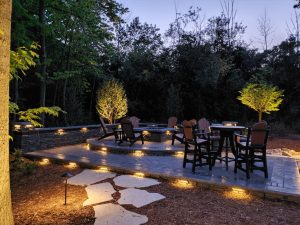Enhancing Outdoor Spaces: Benefits of Low Voltage Landscape Lighting
When it comes to transforming the ambiance and functionality of your outdoor spaces, few options are as versatile and captivating as low voltage landscape lighting. Designed to enhance the beauty of gardens, pathways, and other outdoor areas, low voltage landscape lighting offers a host of benefits, from improved safety and security to creating an inviting atmosphere for outdoor gatherings. In this blog post, we will delve into the world of low voltage landscape lighting, exploring its features, advantages, and practical considerations.
What is Low Voltage Landscape Lighting?
 Low voltage landscape lighting refers to a lighting system that operates on a lower electrical voltage than traditional line voltage systems. While line voltage lighting typically operates at 120 volts, low voltage lighting systems operate at 12 volts or 24 volts. The reduced voltage not only increases safety but also allows for more flexibility in design and installation.
Low voltage landscape lighting refers to a lighting system that operates on a lower electrical voltage than traditional line voltage systems. While line voltage lighting typically operates at 120 volts, low voltage lighting systems operate at 12 volts or 24 volts. The reduced voltage not only increases safety but also allows for more flexibility in design and installation.
Advantages of Low Voltage Landscape Lighting
- Safety: Low voltage landscape lighting significantly reduces the risk of electrical shock, making it a safer option, especially in areas accessible to children and pets. The lower voltage also minimizes the chances of fire hazards, providing peace of mind.
- Energy Efficiency: Compared to high voltage alternatives, low voltage landscape lighting consumes significantly less energy, resulting in reduced electricity bills. This eco-friendly solution also helps to minimize carbon emissions and contributes to a more sustainable environment.
- Minimal Impact on Install: Low voltage landscape lighting systems require less digging and burying of wire compared to a high voltage system. Most installations are completed in a day or two and have minimal effect on your existing landscaping. This is one of the main reasons why clients choose Mike’s Landscape Lighting to install their outdoor lighting.
- Versatility in Design: With low voltage lighting, your designer has the freedom to experiment with various lighting techniques, such as uplighting, downlighting, moonlighting, and path lighting. These options enable you to highlight specific features of your landscape, create dramatic effects, and set the desired mood.
- Extended Lifespan: Low voltage lamps, typically LED-based, have a longer lifespan compared to their high voltage counterparts. LED lamps are known for their durability, low maintenance requirements, and energy efficiency, making them an ideal choice for outdoor lighting applications.
- Enhanced Security: Illuminating your outdoor spaces with low voltage landscape lighting helps deter potential intruders and improves overall security. Well-lit pathways, entrances, and dark corners reduce hiding spots and enhance visibility, promoting a safer environment.
Practical Considerations
- Transformer: A transformer is a crucial component of a low voltage landscape lighting system. It converts the standard 120-volt household current into 12 or 24 volts required for the lighting system. When selecting a transformer, consider the wattage requirements of your lighting fixtures and ensure that the transformer has sufficient capacity to accommodate them.
- Wiring: Low voltage landscape lighting systems use a combination of direct burial cables and connectors. Direct burial cables are designed to withstand outdoor conditions and are buried underground for protection. Connectors enable the connection of the lighting fixtures to the main wiring, allowing for easy customization and adjustments.
- Lighting Fixtures: Choose lighting fixtures that complement your landscape design and serve their intended purpose. There are various options available, including spotlights, path lights, floodlights, and decorative fixtures. Opt for fixtures that are weather-resistant and designed for outdoor use to ensure longevity.
- Design and Placement: Carefully plan the placement of your lighting fixtures to achieve the desired aesthetic and functional effects. Experiment with different angles, heights, and distances to create visual interest and emphasize key elements of your landscape, such as trees, statues, or architectural details.
- Maintenance: Regular maintenance is essential to ensure the longevity and optimal performance of your low voltage landscape lighting system. Inspect the fixtures, clean them as needed, and replace any burnt-out bulbs promptly. Trim vegetation that may obstruct the light or cause shadows to maintain the desired lighting effects.
Low voltage landscape lighting offers a multitude of advantages, including safety, energy efficiency, easy installation, versatility in design, extended lifespan, and enhanced security. By illuminating your outdoor spaces, you can create an inviting atmosphere, highlight the beauty of your landscape, and improve safety and security. Whether you are seeking to transform your garden, accentuate architectural features, or create an enchanting pathway, low voltage landscape lighting provides a flexible and captivating solution. With careful planning, proper installation, and routine maintenance, you can enjoy the benefits of low voltage landscape lighting for years to come.

